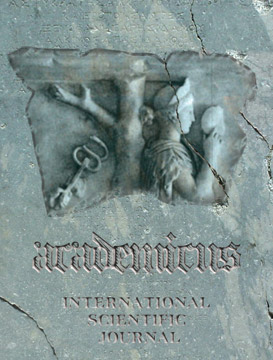Title:
Measurement and evaluation of the public administration performance through delivery of electronic services
Full Reference List:
| 1. | Amber Wichowsky and Donald P. Moynihan. (2008). Measuring How Administration Shapes Citizenship: A PolicyFeedback Perspective on Performance Management, Public Administration Review 68 (5): 908-920. |
| 2. | Batalli, Mirlinda. (2011). Simplification of public administration through use of ICT and other tools European Journal of ePractice · Nº 12 · March/April 2011 · ISSN: 1988-625X, 21-37, www.epracticejournal.eu. |
| 3. | Batalli,Mirlinda. (2011). Impact of Public Administration Innovations on Enhancing the Citizens’ Expectations: International Journal of e-Education, e-Business, e-Management and e-Learning, Vol. 1, No. 2, June, 156. |
| 4. | Batalli, Mirlinda. (2011). Public Administration Reform and Government Responsiveness to Citizens: e-Education, e-Business, e-Management and e-Learning, Published by: International Association of Computer Science and Information Technology Press (IACSIT), |
| 5. | Bouckaert Geert (1995) ‘Improving Performance Measurement’, in A. Halachmi and G.,Bouckaert (eds.) The Enduring Challenges in Public Management, Surviving and Excelling in a Changing World. San Fransisco: Jossey Bass. |
| 6. | Bovaird, T.(2005). Performance Measurement and Evaluation of E-government and E-governance Programmes and Initiatives: Practicing E-government: a Global Perspective. Hershey, PA, USA: Idea Group, Publishing, 16–61. |
| 7. | Brown, K., Repucci. S.(2009). A Users’ Guide to Measuring Public Administration Performance: United Nations Development Programme, Oslo Governance Centre, first edition, 4. |
| 8. | E-Service Delivery. (2007). A manual for delivering E-services as a local government in the digital information society, VNG International Product. The Hague, the Netherlands,4-http://www.vnginternational.nl/fileadmin/user_ upload/downloads/publicationsAn |
| 9. | Economic Policy Committee. (2007). European Commission, Initiatives to improve the efficiency and effectiveness of public spending: Modernizing Public Administration: Directorate General for Economic and Financial Affairs, Brussels, 7 ECFIN/EPC (2007) REP |
| 10. | Geert Bouckaert and John Halligan. (2006). A Framework for Comparative Analysis of Performance Management: Paper for presentation to Study Group on Productivity and Quality in the Public Sector, Conference of European Group of Public Administration, Unive |
| 11. | Hatry, Harry P. (1999). Performance Measurement: Getting Results. Washington, DC: Urban Institute. |
| 12. | Kamarck C. Elaine. (2003). Government Innovation around the World, Ash Institute for Democratic Governance and Innovation,John F. Kennedy School of Government, Harvard University, p3. |
| 13. | Jupp V and Younger M P. (2004). A Value Model for the Public Sector. Accenture. Retrieved April 2, 2008, from http://www.accenture.com. |
| 14. | Lu, J. (2001). Measuring cost/benefits of e-business applications and customer satisfaction: Proceedings of the 2nd International Web Conference, 29–30 November, Perth, Australia, 139-47. |
| 15. | Mettler, Suzanne, and Joe Soss. (2004). The Consequences of Public Policy for Democratic Citizenship: Bridging Policy Studies and Mass Politics. Perspectives on Politics 2: 55 – 73. |
| 16. | M. Vintar, M. Kunstelj and A. Leben. (2004). Benchmarking the Quality of Slovenian Life-Event Portals, in: Improving the Quality of East and West European Public Services, E. Loffler and M.Vintar, eds, Ashgate, Hampshire, 208–221. |
| 17. | McDonald N Blakemore M and Kelleher J. (2007). Think Paper 9: Aarhus Seminar Discussion Paper: Towards a Handbook for Citizen-Centricity, Organizational Change for Citizen-Centric e-Government, e-Government Unit, DG Information Society and Media, European |
| 18. | Musaraj, Arta, and Argita Malltezi-Berisha. “Communication Technologies and the public service: Is it the case of citizens inclusion in the public service standard in Albania?.” Academicus International Scientific Journal 05 (2012): 26-42. |
| 19. | Musaraj, Arta. “Communication processes, public administration and performance evaluation.” Academicus International Scientific Journal 3 (2011): 28-37. |
| 20. | Naujikienė and Dzemydienė. (2012). Evaluation of Public E-Services and Information Technology Accesibility in Different Social Groups: ISSN 2029-7564 (online), SOCIAL TECHNOLOGIES 2(2), 335–348. |
| 21. | Rowley, J. (2006). An analysis of the e-service literature: towards a research agenda. Internet Research, 16 (3), 339-359. |
| 22. | United Nations (2008). E-Government Survey.http://www2.unpan.org/ egovkb/global_reports/10report.htm#sa. |
| 23. | United Nations E-Government Survey (2010). http://unpan3.un.org/egovkb/Portals/egovkb/Documents/un/2010- Survey/ Complete-survey.pdf. |
| 24. | Sheth, Jagdish N., and Arun Sharma (2005).International E-Marketing: Opportunities and Issues,International Marketing Review, 22, 6, 611-22. |
| 25. | Tsohou et al. Evaluating E-Government Services From A Citizens’ Perspective: A Reference Process Model, 146. |
| 26. | Thomas, John C. (1995). Public Participation in PublicDecisions. San Francisco: Jossey-Bass. |
Back to article
Academicus
International Scientific Journal
pISSN 2079-3715
eISSN 2309-1088
Address:
Sheshi i Flamurit, Rruga Muze
Al-9401 Vlorë, Albania
Tel: +355 68 60 60 555
info@academicus.edu.al
https://academicus.edu.al


